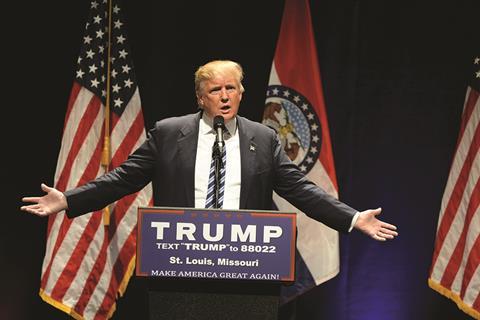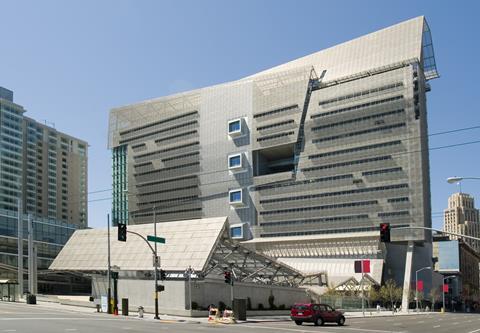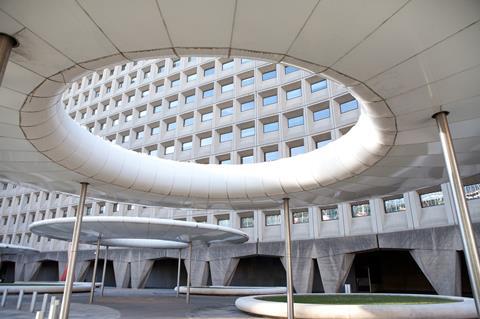Departing president ‘lobs grenade’ with attack on ‘elite architects’ and demand that classical be the default style for federal buildings

Donald Trump has issued a decree that the design of almost all federal buildings over $50m should be classical or traditional in style.
He singled out for opprobrium brutalism, deconstructivism and much more recent projects such Morphosis’ Federal Building in San Francisco, which he said was praised by “elite architects” but that “many San Franciscans consider it one of the ugliest structures in their city”.
He ruled that when such buildings undergo refurbishment the feasibility of giving them a new traditional exterior should be considered.
Trump also announced the creation of an unwieldy President’s Council on Improving Federal Civic Architecture whose 50-plus members are to write his classical preferences into the policies of the General Services Administration (GSA), the body that commissions federal buildings.
This must happen before the council is wound up at the end of September 2021 – unless Joe Biden chooses to prolong the council – said Trump.

The eleventh-hour Executive Order on Promoting Beautiful Federal Civic Architecture, published yesterday, was not completely unexpected since the president had signalled his intention to ban modern architecture altogether in a paper in February called Making Federal Buildings Beautiful Again.
US architecture critic Paul Goldberger said the order was a “weakened version” that could be reversed by the next administration. He described it as “just a chance to lob another grenade on his way out the door”.
This is weakened from the original proposal and in any case is mostly symbolic, just a chance to lob another grenade on his way out the door. I don’t think it means too much. And unlike last-minute pardons, the next administration can mitigate its impact, or reverse it. https://t.co/EBUOKMTKTX
— Paul Goldberger (@paulgoldberger) December 21, 2020
Trump’s argument for ”beauty” over “ugliness” echoes the preoccupation of the current UK government which established a Building Better, Building Beautiful Commission under the later Roger Scruton and whose findings it has vowed to implement.
Beauty has long been a thorny issue in architecture, with everyone from the Prince of Wales to Stephen Fry voicing an opinion on the matter.
As host of Building Design’s Architect of the Year Awards four years ago, the writer and broadcaster told the audience ugliness was a moral failure. But rather than taking aim at brutalism or deconstructivism, he singled out the Trump Taj Mahal casino in Atlantic City - designed by Leo A Daly - as a particularly egregious example, likening it to a marble abattoir.
Trump, a property magnate with dozens of Trump-branded buildings in his portfolio, is known for having a penchant for gold-plated casinos and bling skyscrapers.

Yesterday’s order, signed by Trump, begins with a discussion of architectural history taking in Ancient Greece, Siena and Christopher Wren before moving on to talk about America’s classical heritage, arguing that the founding fathers wanted public buildings to inspire and encourage civic virtue.
“President George Washington and Secretary of State Thomas Jefferson consciously modelled the most important buildings in Washington DC on the classical architecture of ancient Athens and Rome,” he wrote, singling out “cherished landmarks” built over the following 150 years.

Everything went down hill from the 1950s, Trump asserted, when the Ad Hoc Committee on Federal Office Space began encouraging contemporary designs such as Marcel Breuer’s “widely criticised” brutalist Hubert H Humphrey Department of Health and Human Services Building and the Robert C Weaver Department of Housing and Urban Development Building.

He then attacked the GSA’s Design Excellence Programme, established in 1994, for selecting “designs by prominent architects with little regard for local input or regional aesthetic preferences”.
The order goes on to say: “New Federal building designs should, like America’s beloved landmark buildings, uplift and beautify public spaces, inspire the human spirit, ennoble the United States, command respect from the general public, and, as appropriate, respect the architectural heritage of a region. They should also be visibly identifiable as civic buildings and should be selected with input from the local community.
“Classical and other traditional architecture, as practiced both historically and by today’s architects, have proven their ability to meet these design criteria and to more than satisfy today’s functional, technical, and sustainable needs. Their use should be encouraged instead of discouraged.”
This does not exclude other types of architecture so long as those requirements are met – but in DC “classical architecture shall be the preferred and default architecture for federal public buildings”.
The American Institute of Architects (AIA) immediately issued a statement “unequivocally opposing” the order and condemning the mandating of any one style.
“Communities should have the right and responsibility to decide for themselves what architectural design best fits their needs, and we look forward to working with President-Elect Biden to ensure that,” said AIA chief executive Robert Ivy. “Though we are appalled with the administration’s decision to move forward with the design mandate, we are happy the order isn’t as far reaching as previously thought.”
>> Ben Flatman: Whatever happened to The Crown episode where Charles triggers the architects?
Full text of Trump’s decree
Executive Order on Promoting Beautiful Federal Civic Architecture
By the authority vested in me as President by the Constitution and the laws of the United States of America, it is hereby ordered as follows:
Section 1. Purpose. Societies have long recognized the importance of beautiful public architecture. Ancient Greek and Roman public buildings were designed to be sturdy and useful, and also to beautify public spaces and inspire civic pride. Throughout the Middle Ages and the Renaissance, public architecture continued to serve these purposes. The 1309 constitution of the City of Siena required that “[w]hoever rules the City must have the beauty of the City as his foremost preoccupation … because it must provide pride, honor, wealth, and growth to the Sienese citizens, as well as pleasure and happiness to visitors from abroad.” Three centuries later, the great British Architect Sir Christopher Wren declared that “public buildings [are] the ornament of a country. [Architecture] establishes a Nation, draws people and commerce, makes the people love their native country … Architecture aims at eternity[]”
Notable Founding Fathers agreed with these assessments and attached great importance to Federal civic architecture. They wanted America’s public buildings to inspire the American people and encourage civic virtue. President George Washington and Secretary of State Thomas Jefferson consciously modeled the most important buildings in Washington, D.C., on the classical architecture of ancient Athens and Rome. They sought to use classical architecture to visually connect our contemporary Republic with the antecedents of democracy in classical antiquity, reminding citizens not only of their rights but also their responsibilities in maintaining and perpetuating its institutions.
Washington and Jefferson personally oversaw the competitions to design the Capitol Building and the White House. Under the direction and following the vision of these two founders, Pierre Charles L’Enfant designed the Nation’s capital as a classical city. The promise of his design for the city was fulfilled by the 1902 McMillan Plan, which created the National Mall and the Monumental Core as we know them.
For approximately a century and a half following America’s founding, America’s Federal architecture continued to be characterized by beautiful and beloved buildings of largely, though not exclusively, classical design. Examples include the Second Bank of the United States in Philadelphia, Pennsylvania, the Pioneer Courthouse in Portland, Oregon, and the Thurgood Marshall United States Courthouse in New York City, New York. In Washington, D.C., classical buildings such as the White House, the Capitol Building, the Supreme Court, the Department of the Treasury, and the Lincoln Memorial have become iconic symbols of our system of government. These cherished landmarks, built to endure for centuries, have become an important part of our civic life.
In the 1950s, the Federal Government largely replaced traditional designs for new construction with modernist ones. This practice became official policy after the Ad Hoc Committee on Federal Office Space proposed what became known as the Guiding Principles for Federal Architecture (Guiding Principles) in 1962. The Guiding Principles implicitly discouraged classical and other traditional designs known for their beauty, declaring instead that the Government should use “contemporary” designs.
The Federal architecture that ensued, overseen by the General Services Administration (GSA), was often unpopular with Americans. The new buildings ranged from the undistinguished to designs even GSA now admits many in the public found unappealing. In Washington, D.C., new Federal buildings visibly clashed with the existing classical architecture. Some of these structures, such as the Hubert H. Humphrey Department of Health and Human Services Building and the Robert C. Weaver Department of Housing and Urban Development Building, were controversial, attracting widespread criticism for their Brutalist designs.

In 1994, GSA responded to this widespread criticism that the buildings it had been commissioning lacked distinction by establishing the Design Excellence Program. The GSA intended that program to advance the Guiding Principles’ mandate that Federal architecture “provide visual testimony to the dignity, enterprise, vigor, and stability of the American Government.” Unfortunately, the program has not met this goal.
Under the Design Excellence Program, GSA has often selected designs by prominent architects with little regard for local input or regional aesthetic preferences. The resulting Federal architecture sometimes impresses the architectural elite, but not the American people who the buildings are meant to serve. Many of these new Federal buildings are not even visibly identifiable as civic buildings.
For example, GSA selected an architect to design the San Francisco Federal Building who describes his designs as “art-for-art’s-sake” architecture, intended primarily for architects to appreciate. While elite architects praised the resulting building, many San Franciscans consider it one of the ugliest structures in their city. Similarly, GSA selected a modernist architect to design Salt Lake City’s new Federal courthouse. The architectural establishment and its professional organizations praised his unique creation, but many local residents considered it ugly and inconsistent with its surroundings. In Orlando, Florida, a coalition of judges, court employees, and civic leaders opposed GSA’s preferred modernist design for the George C. Young Federal Courthouse. They believed it lacked the dignity a Federal courthouse should embody. The GSA nonetheless imposed this design over their objections.
With a limited number of exceptions, such as the Tuscaloosa Federal Building and Courthouse and the Corpus Christi Federal Courthouse, the Federal Government has largely stopped building beautiful buildings. In Washington, D.C., Federal architecture has become a discordant mixture of classical and modernist designs.
It is time to update the policies guiding Federal architecture to address these problems and ensure that architects designing Federal buildings serve their clients, the American people. New Federal building designs should, like America’s beloved landmark buildings, uplift and beautify public spaces, inspire the human spirit, ennoble the United States, command respect from the general public, and, as appropriate, respect the architectural heritage of a region. They should also be visibly identifiable as civic buildings and should be selected with input from the local community.
Classical and other traditional architecture, as practiced both historically and by today’s architects, have proven their ability to meet these design criteria and to more than satisfy today’s functional, technical, and sustainable needs. Their use should be encouraged instead of discouraged.
Encouraging classical and traditional architecture does not exclude using most other styles of architecture, where appropriate. Care must be taken, however, to ensure that all Federal building designs command respect of the general public for their beauty and visual embodiment of America’s ideals.
Sec. 2. Policy. (a) Applicable Federal public buildings should uplift and beautify public spaces, inspire the human spirit, ennoble the United States, and command respect from the general public. They should also be visually identifiable as civic buildings and, as appropriate, respect regional architectural heritage. Architecture — with particular regard for traditional and classical architecture — that meets the criteria set forth in this subsection is the preferred architecture for applicable Federal public buildings. In the District of Columbia, classical architecture shall be the preferred and default architecture for Federal public buildings absent exceptional factors necessitating another kind of architecture.
(b) Where the architecture of applicable Federal public buildings diverges from the preferred architecture set forth in subsection (a) of this section, great care and consideration must be taken to choose a design that commands respect from the general public and clearly conveys to the general public the dignity, enterprise, vigor, and stability of America’s system of self-government.
(c) When renovating, reducing, or expanding applicable Federal public buildings that do not meet the criteria set forth in subsection (a) of this section, the feasibility and potential expense of building redesign to meet those criteria should be examined. Where feasible and economical, such redesign should be given substantial consideration, especially with regard to the building’s exterior.
(d) GSA should seek input from the future users of applicable public buildings and the general public in the community where such buildings will be located before selecting an architectural firm or design style.
Sec. 3. Definitions. For the purposes of this order:
(a) “Applicable Federal public building” means:
(i) all Federal courthouses and agency headquarters;
(ii) all Federal public buildings in the District of Columbia; and
(iii) all other Federal public buildings that cost or are expected to cost more than $50 million in 2020 dollars to design, build, and finish, but does not include infrastructure projects or land ports of entry.
(b) “Brutalist” means the style of architecture that grew out of the early 20th-century modernist movement that is characterized by a massive and block-like appearance with a rigid geometric style and large-scale use of exposed poured concrete.
(c) “Classical architecture” means the architectural tradition derived from the forms, principles, and vocabulary of the architecture of Greek and Roman antiquity, and as later developed and expanded upon by such Renaissance architects as Alberti, Brunelleschi, Michelangelo, and Palladio; such Enlightenment masters as Robert Adam, John Soane, and Christopher Wren; such 19th-century architects as Benjamin Henry Latrobe, Robert Mills, and Thomas U. Walter; and such 20th-century practitioners as Julian Abele, Daniel Burnham, Charles F. McKim, John Russell Pope, Julia Morgan, and the firm of Delano and Aldrich. Classical architecture encompasses such styles as Neoclassical, Georgian, Federal, Greek Revival, Beaux-Arts, and Art Deco.
(d) “Deconstructivist” means the style of architecture generally known as “deconstructivism” that emerged during the late 1980s that subverts the traditional values of architecture through such features as fragmentation, disorder, discontinuity, distortion, skewed geometry, and the appearance of instability.
(e) “General public” means members of the public who are not:
(i) artists, architects, engineers, art or architecture critics, instructors or professors of art or architecture, or members of the building industry; or
(ii) affiliated with any interest group, trade association, or any other organization whose membership is financially affected by decisions involving the design, construction, or remodeling of public buildings.
(f) “Officer” has the meaning given that term in section 2104 of title 5, United States Code.
(g) “Public building” has the meaning given that term in section 3301(a)(5) of title 40, United States Code.
(h) “Traditional architecture” includes classical architecture, as defined herein, and also includes the historic humanistic architecture such as Gothic, Romanesque, Pueblo Revival, Spanish Colonial, and other Mediterranean styles of architecture historically rooted in various regions of America.
(i) “2020 dollars” means dollars adjusted for inflation using the Bureau of Economic Analysis’s Gross Domestic Product price deflator and using 2020 as the base year.
Sec. 4. President’s Council on Improving Federal Civic Architecture. (a) There is hereby established the President’s Council on Improving Federal Civic Architecture (Council).
(b) The Council shall be composed of:
(i) all of the members of the Commission of Fine Arts;
(ii) the Secretary of the Commission of Fine Arts;
(iii) the Architect of the Capitol;
(iv) the Commissioner of the GSA Public Building Service;
(v) the Chief Architect of GSA;
(vi) other officers or employees of the Federal Government as the President may, from time to time, designate; and
(vii) up to 20 additional members appointed by the President from among citizens from outside the Federal Government to provide diverse perspectives on the matters falling under the Council’s jurisdiction.
(c) The Council shall be chaired by a member of the Commission of Fine Arts designated by the President. The Chair may designate a vice-chair and may establish subcommittees.
(d) The members of the Council shall serve without compensation for their work on the Council. However, members of the Council, while engaged in the work of the Council, may receive travel expenses, including per diem in lieu of subsistence, as authorized by law for persons serving intermittently in the government service, pursuant to sections 5701 through 5707 of title 5, United States Code.
(e) To the extent permitted by law and within existing appropriations, the Administrator of General Services (Administrator) shall provide such funding and administrative and technical support as the Council may require. The Administrator shall, to the extent permitted by law, direct GSA staff to provide any relevant information the Council requests and may detail such staff to aid the work of the Council, at the request of the Council.
(f) Insofar as the Federal Advisory Committee Act, as amended (5 U.S.C. App.), may apply to the Council, any functions of the President under that Act, except that of reporting to the Congress under section 6 of that Act, shall be performed by the Administrator in accordance with the guidelines and procedures established by the Administrator.
(g) The Council shall terminate on September 30, 2021, unless extended by the President. Members appointed under subsections (b)(vi) and (b)(vii) of this section shall serve until the Council terminates and shall not be removed except for inefficiency, neglect of duty, or malfeasance.
Sec. 5. Responsibilities of the Council. The Council shall:
(a) submit a report to the Administrator, recommending updates to GSA’s policies and procedures to incorporate the policies of section 2 of this order and advance the purposes of this order. The report shall explain how the recommended changes accomplish these purposes. The report shall be submitted prior to September 30, 2021.
(b) recommend to the Administrator changes to GSA policies for situations in which the agency participates in a design selection pursuant to the Commemorative Works Act (chapter 89 of title 40, United States Code), in furtherance of the purposes of this order and consistent with applicable law.
Sec. 6. Agency Actions. (a) The Administrator shall adhere to the policies set forth in section 2 of this order.
(b) In the event the Administrator proposes to approve a design for a new applicable Federal public building that diverges from the preferred architecture set forth in subsection 2(a) of this order, including Brutalist or Deconstructivist architecture or any design derived from or related to these types of architecture, the Administrator shall notify the President through the Assistant to the President for Domestic Policy not less than 30 days before GSA could reject such design without incurring substantial expenditures. Such notification shall set forth the reasons the Administrator proposes to approve such design, including:
(i) a detailed explanation of why the Administrator believes selecting such design is justified, with particular focus on whether such design is as beautiful and reflective of the dignity, enterprise, vigor, and stability of the American system of self-government as alternative designs of comparable cost using preferred architecture;
(ii) the total expected cost of adopting the proposed design, including estimated maintenance and replacement costs throughout its expected lifecycle; and
(iii) a description of the designs using preferred architecture seriously considered for such project and the total expected cost of adopting such designs, including estimated maintenance and replacement costs throughout their expected lifecycles.
Sec. 7. General Provisions. (a) Nothing in this order shall be construed to impair or otherwise affect:
(i) the authority granted by law to an executive department or agency, or the head thereof; or
(ii) the functions of the Director of the Office of Management and Budget relating to budgetary, administrative, or legislative proposals.
(b) This order shall be implemented consistent with applicable law and subject to the availability of appropriations.
(c) This order is not intended to, and does not, create any right or benefit, substantive or procedural, enforceable at law or in equity by any party against the United States, its departments, agencies, or entities, its officers, employees, or agents, or any other person.
DONALD J. TRUMP
THE WHITE HOUSE,
December 18, 2020.
















10 Readers' comments